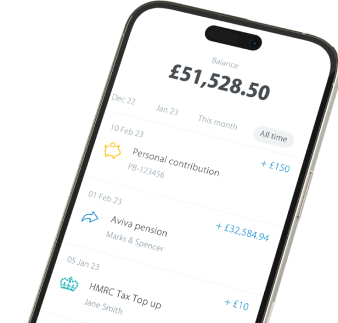
This article was last updated on 22/11/2024
Self-employment comes with tremendous freedom but it can also mean more financial responsibilities. If you’re a sole trader or director of your own company, chances are your financial priorities are, in no particular order: chasing up invoices, paying invoices, liaising with an accountant and dealing with bank admin. As this list isn’t exhaustive, it’s no wonder self-employed workers are those least likely to pay into a pension.
The Office for National Statistics (ONS) found that self-employed workers aged 35-54 are more than twice as likely to have no pension than workers who are employed by a company. This is a shame because there are many financial benefits to saving into a pension aside from building a healthy retirement fund.
Pensions equal free money
Anyone employed by a company, age 22 or older and who earns over £10,000 a year will be paying at least 5% of their qualified earnings into a workplace pension, unless they’ve opted out. Under these rules, known as Auto-Enrolment, an employer has to set up a pension for its eligible employees and also commits to topping that up with an amount worth at least 3% of their qualified earnings. While that ‘free money’ might not be available if you’re self-employed, there’s one big advantage to setting up a pension - you don’t pay tax on the money you pay in.
Self-employment pension rules explained
You can receive tax relief on pension contributions of up to £60,000 gross a year (known as the annual allowance), or 100% of your salary for the tax year 2024/25.
A basic rate taxpayer gets a 25% tax top up, so for every £100 they put into their personal pension, HMRC adds an extra £25. If you’re a higher or additional rate taxpayer, you can claim further relief through your Self-Assessment tax return.
Any unused annual allowance from up to the previous three tax years can be put into the pension. This is called ‘carry forward‘ and can be up to £180,000 on top of your current year’s annual allowance.
How do I pay into a pension if I’m self-employed?
There are several different types of pension and how you set up your pension will depend on your own circumstances. Below are some things to consider.
How you like to manage your money/savings: do you want to spend time managing some of the money in the pension yourself, or do you want it all managed for you?
How much do you plan to pay in?
How near are you to retirement?
What type of company set up do you have: are you a sole trader or do you run your business through a limited company of which you’re a director?
What type of self-employed pension should I have?
There are two main types of pensions: workplace pensions which we’ve already mentioned, and personal pensions. If you’re self-employed, a personal pension will normally be your best option. It’s easy to set up a personal pension. These come in three main types:
an ordinary pension scheme;
stakeholder pension; and
a Self-Invested Personal Pension (SIPP).
What type of personal pension should I choose?
Personal pensions are offered by most pension companies.
Stakeholder pensions have capped charges but have a more limited choice of investments.
An ordinary personal pension will give you a choice of investments, these will normally be managed funds which include a mix of shares and other stock market listed assets. You need to compare charges and fees when considering which type of personal pension to pay into.
If you’re a more active investor, for example, you already own some shares and dabble in the stock market, then a Self-Employed Personal Pension (SIPP) may be worth considering. SIPPs can include collective investments, such as unit trusts or investment trusts. They can also include property and land and some SIPPs will allow you to invest in residential property through real estate investment trusts (REITs); these are also a collective investment, including the shares or assets of a number of companies.
What happens to my tax?
When you set up a personal pension your pension provider will claim back the tax relief for you, and reinvest it back into your pension. Most basic rate taxpayers usually get a 25% tax top up and higher and additional rate taxpayers can claim a further 25% and 31% respectively through a Self-Assessment tax return. The tax incentive is offered because the government wants to promote saving for later life.
A pension is a long-term savings plan which comes with some risk. Because pension savings are invested, they have the potential to grow into a large sum or fall in value over time.
Do I need to have a special pension if I have a limited company?
If you run a limited company, you can pay into a pension in two different ways:
personally, using the salary your limited company pays you; or
direct, as an employer.
If you pay into a pension as an employer then any payments are considered a business expense, so they can usually be offset against your company’s corporation tax bill. It’s worth noting that if you’re paying your pension through your salary, dividends don’t count as earnings and are taxed separately.
Limited companies can use pension contributions to offset their tax and the ‘carry forward‘ rule means you can backdate any of your unused annual allowance from the previous three tax years.
How much tax can I save by contributing to my pension?
If you’re a company director of a limited company you can pay up to £60,000 and offset your corporation tax bill, corporation tax is 25%. If you’re a sole trader or have a PAYE salary paid through your company, you can claim extra tax relief if you fall into a higher tax bracket by completing a Self-Assessment.
How do I choose a pension?
Not all pensions are the same, although you’ll have the same tax benefits regardless of which provider you go with. You’ll need to look around and compare different pension providers, or if you have a financial adviser it may be worth seeing if they can offer pension advice, although you’ll have to pay for this.
Other things to consider are:
minimum contributions - some providers will have a minimum contribution level;
ability to pay in lump sum or stop and start my contributions - if you’re not paid a regular salary you may only want to make one payment a year;
charges for managing my money - this might be an annual fee or a management fee; and
what type of plan you want to invest in - does the provider offer a sustainable investment option?
Saving on National Insurance
Employers don’t have to pay National Insurance on pension contributions. This is another reason why it may be more tax-efficient to pay into a pension directly from your limited company rather than personally through a salary.
Do I get a State Pension if I’m self-employed?
You’ll need to have at least 10 qualifying years of National Insurance contributions to be eligible for the UK State Pension, and you’ll need 35 years in total to receive the maximum State Pension amount.They don’t have to be 35 years in a row and if you qualify, you’ll get the full new State Pension which is currently £221.20 per week. You’ll usually need to pay your National Insurance contributions through your Self-Assessment tax return. Self-employed workers will need to pay the Class 4 National Insurance rate.
Samantha Downes is a financial journalist and has written for most national newspapers and women’s magazines. She is also the author of two finance guides and has set up the Substack PumpkinPensions to help guide people looking to save more towards their future.
Risk warning
As always with investments, your capital is at risk. The value of your investment can go down as well as up, and you may get back less than you invest. This information should not be regarded as financial advice.






